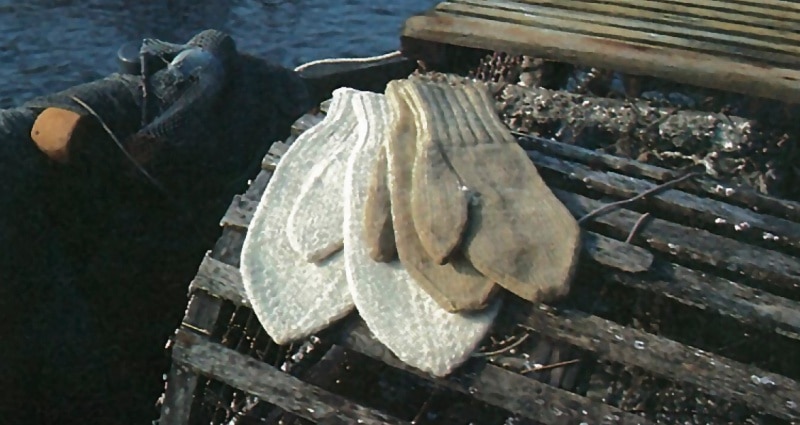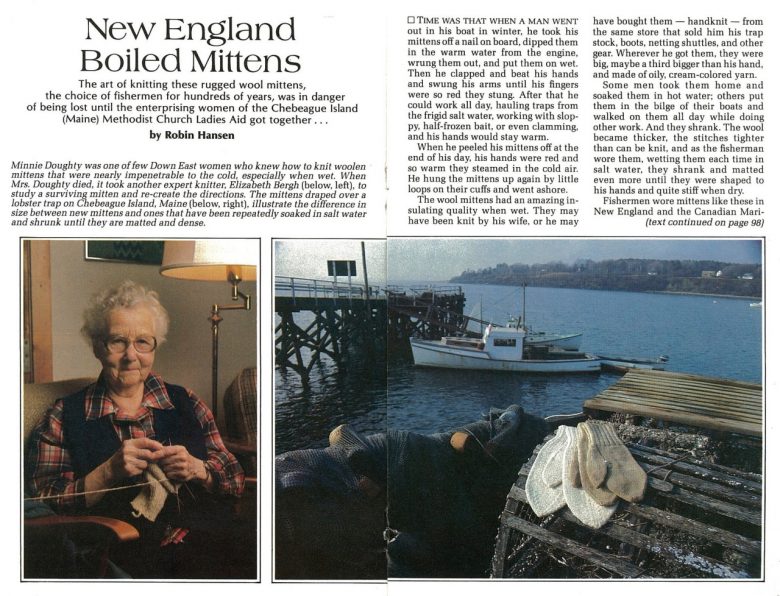New England Boiled Wool Mittens | Yankee Classic
The art of knitting boiled wool mittens, the top choice of fishermen, was highlighted (with instructions!) in this Yankee feature from 1983.

Coffee By Design | Portland, Maine
Photo Credit : Katherine KeenanThe art of knitting rugged boiled wool mittens, the choice of fishermen for hundreds of years, was in danger of being lost. That is, until the enterprising women of the Chebeague Island Methodist Church Ladies Aid in Maine got together…

Photo Credit : Yankee Magazine/February 1983
Time was that when a man went out in his boat in winter, he took his wool mittens off a nail on board, dipped them in the warm water from the engine, wrung them out, and put them on wet. Then he clapped and beat his hands and swung his arms until his fingers were so red they stung. After that he could work all day, hauling traps from the frigid salt water, working with sloppy, half-frozen bait, or even clamming, and his hands would stay warm.
When he peeled his mittens off at the end of his day, his hands were red and so warm they steamed in the cold air. He hung the mittens up again by little loops on their cuffs and went ashore.
The boiled wool mittens had an amazing insulating quality when wet. They may have been knit by his wife, or he may have bought them — handknit — from the same store that sold him his trap stock, boots, netting shuttles, and other gear. Wherever he got them, they were big, maybe a third bigger than his hand, and made of oily, cream-colored yarn. Some men took them home and soaked them in hot water; others put them in the bilge of their boats and walked on them all day while doing other work. And they shrank. The wool became thicker, the stitches tighter than can be knit, and as the fisherman wore them, wetting them each time in salt water, they shrank and matted even more until they were shaped to his hands and quite stiff when dry.
Fishermen wore mittens like these in New England and the Canadian Maritime Provinces for hundreds of years. Some still do, when they can get them.
The downfall of the fishermen’s boiled wool mittens came with the rise of the insulated glove, which on the surface sounds a lot more reasonable. Bulky and rubbery, the insulated glove is warm enough, but doesn’t permit much fine finger movement or any feeling through its layers. Some fishermen use them only for the prickly work of handling bait, complaining that they “can’t work in them.”
In many fishing communities, the art of knitting fishermen’s mittens has been lost, and even those women who wanted to knit them for their husbands couldn’t. There were no mittens left to measure, and no women left who knew how to make them.
This was the case on Chebeague Island, off Portland, until a few years ago. Minnie Doughty, the one woman who had maintained the skill, died, taking her knowledge with her. Like many other coastal women, Mrs. Doughty had had a difficult life and had lost several of her six sons to the sea. In her lifetime she had knitted a great many pairs of fishermen’s mittens — so many that when she died, the single remaining new pair was treasured as a keepsake by her daughters.
One of the expert knitters of the Chebeague Island Methodist Church Ladies Aid, Elizabeth Bergh, took these old mittens, counted stitches, measured, found a loose end to determine the thickness of the yarn, and put together instructions for fishermen’s mittens. The Ladies Aid knitters tried out the instructions, then continued knitting until they had a small pile of mittens. They “sold like hotcakes” at their fair, Miss Bergh recalled.
If you have a fisherman in the family, or if you spend much of the winter by the sea, try knitting a pair of these remarkably warm, thick, almost water-repellent mittens for someone in your family.
Here are Elizabeth Bergh’s instructions, based on Minnie Doughty’s mittens. They are probably the only instructions in print anywhere for this kind of mitten. But beware! They make a huge mitten that must be shrunk in salt water, and really can be used only in the traditional way.
The yarn traditionally used for these mittens on Chebeague Island is cream-colored, 3-ply natural Fisherman Yarn from Bartlett yarns in Harmony, Maine. This is half again as heavy as worsted weight yarn and makes an astoundingly dense mitten. Some women use Bartlett yarns 2-ply Fisherman Yarn, a worsted-weight, oiled, wool yarn, which is easier to knit and makes a lighter, more flexible mitten. The pattern is the same for the two weights of yarn. Any oiled fisherman yarn in these weights can be substituted for the Bartlett yarns Fisherman Yarn.
Instructions are for a man’s medium-sized mitten. To knit a child’s size, find a mitten pattern for worsted-weight yarn and knit a full size larger—for example, a size eight for a six-year-old—then shrink the mittens. Wool mittens shrink anyway, but few patterns take this into account.
BOILED WOOL MITTEN PATTERN DIRECTIONS
Yarn: Two skeins Bartlett yarns, 2- or 3-ply fisherman yarn, or other worsted-weight wool with lanolin, used singly.
Equipment: Four number 4 double-pointed needles, or size needed to knit correct gauge.
Gauge: Five stitches equal one inch.
On size four double-pointed needles, cast on 12, 15, and 15 stitches, a total of 42 stitches on three needles. Knit two, purl one until wristband measures four inches.
Then, first round: place last purl stitch on first needle. Purl one, knit two, purl one. Knit rest of round, increasing two stitches on each needle for a total of 48 stitches.
Second round: start thumb gore. Purl one, increasing one stitch in each of the next two stitches, purl one. Knit around, and knit rounds three, four, and five, maintaining the two purl stitches as a marker.
Sixth round: purl one, increase in the next stitch, knit two, increase in the next stitch, purl one (eight stitches, including two purls). Knit around. Knit three more rounds.
Continue to increase this way every fourth row until you have 14 stitches for the thumb gore, including the two purl stitches. Knit three more rounds and place the 14 stitches on a string.
Cast on 10 stitches to bridge the gap and divide the stitches 18 to a needle (total 54 stitches). Knit up 4 to 4-1/2 inches from thumb for the hand.
Begin decreasing in next round:
Knit two together, knit seven. Repeat around. Knit two rounds. Knit two together, knit six, and repeat around. Knit two rounds. Knit two together, knit five, and repeat around. Knit two rounds. Knit two together, knit four, and repeat around. Knit one round. Knit two together, knit three, and repeat around. Knit one round. Knit two together around. Break the yarn and draw up the remaining stitches on the tail, using a yarn needle. Darn the tail back and forth across the tip of the mitten. Thumb: Pick up from thumb gore seven stitches on each of two needles and one stitch from each side of the thumbhole, a total of 16 stitches on two needles. Pick up the 10 stitches from the palm side of the thumbhole on a third needle. Knit two rounds. Next round, decrease one stitch on each end of the third needle. There are now eight stitches on each needle. Knit 2 to 2-1/2 inches.
Next round, decrease: knit two together, knit two, and repeat around. Knit one round. Next round, knit two together, knit one, and repeat around. Break yarn and draw up remaining stitches on the tall, using a yarn needle. Darn the end into the tip of the thumb. Work all other loose ends into the fabric of the mitten.
Crochet a loop at the edge of the cuff for hanging the mitten to dry. Use the tail left from casting on, if possible. To shrink: soak the mittens in boiling hot water, squeeze them out and dry them on a radiator. I shrink mine in the drier on the hot setting, but this takes out some of the oil. Some men say to dry them in the freezer. This takes a long, long time. Some claim they soak their mittens in fish gore, then wash them in hot water. However you choose to shrink your mittens, the first shrinking will not complete the trick, but the mittens will continue to shrink in use. Don’t give up.








I love your article on boiled mittens. I had been buying mittens socks and gloves in the boiled mittens style for some years and then I couldnt find them on line anywhere. I saw your article and did a new google search to see where to buy, i am not a knitter, and found http://www.sweaterchalet.com which has sweaters but also boiled wool everything else and they seem to be hand knitted in Austria.
Thanks Yankee Magazine
| am UK based and unsure what size needles I need. I was assuming no 4 is US size, translating to 3.5mm, but that seems very small for this project. Old UK no 4 would be 6mm which seems more reasonable. Can anyone advise? Thanks
I’ve gone with US No. 6 of late, which converts to UK 8, or 4mm, needles. This gives the stitches a little more space to shrink when you full the mittens.
You are correct on your conversion.I hope this helps, a size 4 needle converts to 3.5mm per my needle conversion chart. I wish I knew more about my iphone and computer, I would post a picture of my chart.
Also, I have made these mittens several times. They run a little large.
This pattern is old, like very old. I’ve since revised it somewhat, and suggest needle size US 6/4 mm/Can Size 8 — which I think is the same as British 8. You can find the revised pattern complete with shrinking directions in my books FAVORITE MITTENS or ULTIMATE MITTENS, both from Down East Books.
The mittens do run large, because they are meant to be fulled to size. The technique of fulling, explained in a later Yanke article, is not explained above, but I will tell you:
You need 2 good-sized dishpans or smallish washbasins, real soap or soap based shampoo (We use Orvus horse shampoo or plain Murphy’s Oil Soap), a wash board or felting board, a scrub brush, and a large pot of boiling water and a source of pretty cold water.
Maine fishermen shrink their mittens — I have now learned — by wetting them in the cooling water from their engine, throwing them on the deck and walking on them as they work. Now and then, they lay them on the engine manifold to heat them up, watching them and turning them to keep them from scorching, while possibly eating their lunch or drinking a cuppa. Then, back in the cooling water, back on the deck. By the end of the day, the mittens are shrunk and fit well. We approximate this in the kitchen with hot and cold water, soap, and a washboard.
Start by tracing around the mitten with a crayon or a marker on a large piece of paper — newspaper or a paper bag. Then you can compare the size as they shrink. They should shrink about 20 percent lengthwise, about 10 percent widthwise. NEVER knit these with Superwash preshrunk wool or any synthetic or synthetic blend, which will not shrink at all.
The mittens are shrunk NOT by boiling but by the shock of going from hot water to cold, by agitation (against the washboard), and by using lots of soap. The soap also helps to get those wool fibers to slip past one another.
PROCESS: Fill one dishpan with water as hot as you can stand to put your hands in (Cool it to bearable with a little cold water). Fill the other with seriously cold water, either from the tap or iced.
Dunk the mittens in the hot water, rub soap lavishly into them, then scrub them on the washboard, wetting them thoroughly often with the hot water. Scrub them inside and out. Scrub both sides of the thumb.
When tired of this, submerge the mittens in ice cold water and quickly squeeze cold water through them until there’s no warmth. Back in the hot, more soap, and the washboard. You will feel them relax in the hot water, pull up in the cold. (This happens to the wool on the back of the sheep as well when they’re warm or cold.)
Go back and forth like this from hot to cold and cold to hot until the mittens give up the ghost and stay tightened up even in the hot water. Lay them on your paper outline. Try them on. When they are small enough, use the scrub brush to brush up the nap, brushing toward the tip and starting at the tip, then proceding back to the cuff. Your mittens should come out nice and hairy, looking as if they were knitted by a grandmother for a favorite fishing grandson.
Hello Robin! Is there any way I can get in contact with you? I’d love to purchase some of these mittens from the women of the Chebeague Island Methodist Church Ladies Aid in Maine. I’d like to buy from them if still possible. Do you by any chance know how to contact them? My extremities get cold occasionally and I feel like some mittens like this would be of great help.
Hi, Victor. I’m contacting the Chebeague Island Methodist Church to see if the ladies there are still making fisherman’s mittens for sale, lo these 38 years later. I’ll get back to you with their answer.
Who would make me a pair of fisherman’s mittens. I have a brother use lobster fished for 40 years. It would make a great surprise gift.
Bruce, I can if you’re not in a hurry.
My father showed me mittens line these in an Army/Navy store. He had gone fishing in the North
Atlantic in his teens and he explained the shrinking process. So glad to see that the method and pattern has been preserved.
What a delight to see this wonderful old article on boiled mittens from 30+ years ago. My eight children have given me twenty-three grandchildren. I can’t count how many pairs of these wonderful mittens I have made. Thank you for the memories. Mary S
Mary, what a wonderful gift you have given so many members of your family. Sure to be treasured for many years to come. Have you ever considered making some mittens for some non-family members who do not knit but who would truly treasure a pair of these (and pay accordingly)?
Nowadays most of us Knitters throw the mittens in the washing machine until they shrunk down.
Has anyone knit these on circular needles?
I’ve knit it twice on #8 wooden needles from KnitPicks and they come out really well. My son says they’re the best and he works outside as a carpenter in Maine. I imagine you could use very short fixed circular needles, but from trying to switch out to the short ones (9″) for socks I found it’s almost too small and it cramps the hands and the dbl. pointed were easy to use. Post if you do use the circs.
Nancy — use 2 circular needles or one set of circular needles with a very long cable. Search on YouTube for Magic Cable (socks or mittens) or knitting socks/mittens with 2 circular needles.
You might also consider using the new Flexiflips which are needles with a flexible middle section – I started using them for socks and find that they are much easier on my hands.
I make mine with the flexiflips and love it – stitches stay on the needles better so it’s great if you take your knitting with you.
A much easier method: shrink wool material (I use discarded sweaters), then sew, double layers, on machine.
Can these mittens be crocheted?
That is a good question—that you’ve asked twice and no one has answered. I have never tried to crochet a fisherman’s wet mitten, nor have I ever seen one in my wanderings around north Atlantic coasts. I would suggest you try it, possibly using a single crochet (as the least holey crochet st) and then do the whole shrinking exercise, which you can find below in an earlier comment by me. Let me know how it works. I would think they might come out a little overly heavy, but maybe not. Try using the measurements for fishermen’s mittens in my book Ultimate Mittens or Favorite Mittens (Your library may have lone or the other if you’re in New England.) and expect about 20 percent shrinkage lengthwise, less widthwise. Good luck!
I crocheted some wool socks for my grand daughter. Baby sitter through them in the wash . They shrunk to a tight thick fabric. We are now saving them for the recently born twins.
You can crochet them, but it’s not going to be the same density of stitch that you can get with the knit pattern, size of needle and knit gauge. I’ve found crocheted products don’t felt “down” the same way as knitted items….they don’t shrink the same way. If none of that matters to you….then don’t worry about it.
I like other commentors would like to have a pair made. My mom has been gone few years now, she made me one pair and only made more for the grandkids, said a man should only wear out two pieces of clothes, socks and underwear so I only got one pair and told to take care of them.
Mike, I am in the middle of a pair now. Let me know if you still need them.
I went to PEI several years ago and founf the thrummed mitten there. Ive made tons of these steel hot mittens. They get wet, who cares they are warm!
CAN YOU CROCHET THEM ? IF SO INSTRUCTIONS PLEASE 🙂
I came across this article today on NETL. I found it so interesting about the Boiled Wool Mittens. Would love to have a pair for my grand nephew Danny, he’s in Upstate NY and its cold. I don’t knit so can someone tell me the price if I can find a dear person to make for me.
Maureen, I would love to knit you a pair just for fun if you’re still interested! I just moved up to Vermont and am knitting my way through the winter. I want to make more of these to get better and faster at making them because they really are so warm.
The directions aren’t really laid out very clearly. This is going to take me a while to decipher!
I have been knitting for 60 years and never tried these. Now my curiosity is piqued, and I’d like to try some. Wish me luck!.
Does anybody know if these are also warm when they’re dry?
I’d also like to know if they can be used in freshwater once there shrunk: are they still warm when worn?
They are warm while dry and wet. Freshwater the same as salt.
They are warm both wet and dry, but are somewhat more wind and water-repellent when damp. Wet them, then wring them out.
I have knit this pattern many times and felted them as far as they could go. Doing so makes the mitt a bit water repellent. I also add extra lanolin to the hot water while shrinking the mitts. I altered the pattern by number of stitches for different sized hands as well. I have found the original pattern will fit a small woman’s hand. I have knit this mitt up to a size xxl mans hand. I love these mitts and so do many of my family members. Down to -50C in the Yukon, with a light shell these are the way to go.
Hello Marilyn, do you by any chance have written instructions for the altered sizes that you could send to me? I am in the process of making a set for my father, but I think they will end up too small and I will have to make a new pair in a larger size. It would be so much easier if i had clearer instructions for a large size as I have never altered a pattern before.
Can anyone help me understand what it means by “place last pearl stitch on first needle”? This is my first time trying knitting anything besides a scarf!
Hi Victoria! If you’re still wondering about placing that last purl stitch, I took the last purl stitch from the ribbed cuff (off of my right needle) and slipped it over to my left needle BEFORE purling it to finish the cuff. In other words, right as I came to the last stitch of my cuff, before switching to knitting the hand of the mitten, I slipped it over to my left needle and proceeded with the rest of the directions. So that last purl stitch of the cuff becomes the first purl stitch of what will become the thumb gore for the mitten hand. I hope this helps- it’s tricky trying to describe knitting like this but I love this pattern and my mom swears these are the warmest mittens she’s had. I’m finishing up a pair for my dad now (although I just caught a mistake I made down by the thumb… ugh!). I hope you enjoy this project!
Has anyone successfully shrunk the mittens using a washing machine and dryer? If so, what settings did you use? This would be much easier than using a washboard, etc, but I’m a little afraid that the washing machine will somehow ruin them if I don’t do it right!
They last forever.. I still have the same ones my boyfriends’ mom knit for me 45 yrs ago!
Hi! I am a knitter because we used to have sheep and I love knitting. I would like to have this pattern in men (large size) if available. Thank you!
Strangely enough I still have my heavy mittens from the old towrope days of down hill skiing. I use them when I’m shoveling in the cold. Interesting article..